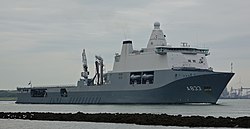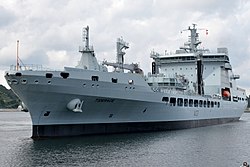Background




The preliminary ideas for joint support ships arose from the development of "helicopter carriers", classes of vessels such as landing platform docks (LPDs) and landing helicopter docks (LHDs) designed for the operation of rotary-wing and other types of vertical take-off and landing (VTOL) aircraft. Unlike conventional fixed-wing aircraft carriers, these vessels do not require steam catapults for the launching of aircraft or arresting cables for the recovery or aircraft, and thus provided more space below the flight deck which could be utilised for other purposes. Some early LHDs were converted World War II-era aircraft carriers such as the United States Navy (USN)'s Essex-class vessels, but later designs often featured non-full length flight decks, usually at rear of the vessel. [1]
While initial emphasis was placed upon airborne operations, as the need for combined forces capabilities grew, facilitating amphibious operations also became a requirement, and later designs such as the Royal Navy (RN)'s Fearless-class LPD emerged featuring a well dock to launch and recover personnel, vehicular and utility landing craft, and in the case of the USN's Austin-class LPD, Tarawa-class landing helicopter assault (LHA) and other similar classes of vessels, tracked amphibious landing vehicles such as the AAVP-7A1. [1] [2]
To support the air- and sea-going craft these vessels carried, they often featured fuel bunkers with increased storage capacity, and were often utilised as supplementary auxiliary ships to provide underway replenishment (UNREPs) to other vessels. Their absence of large calibre weapons on weather decks and with increased storage space below, they also proved very useful at sealift operations. Many also had onboard hospital facilities and the vessels served as casualty evacuation vessels. These multiple roles were demonstrated in 1956 during the Suez Crisis, where the helicopters of HMS Ocean (R68), a former World War II aircraft carrier repurposed to a helicopter carrier, were not only used to transport Royal Marines to the shore but supplies and other cargo as well, and return with wounded troops. With a combination of army (or marine) and navy personnel and aircrew onboard, and often equipped with a wide range of sensor suites, these vessels were utilised as ad-hoc or formal joint command and control centres, as demonstrated during the Vietnam War, the Falklands War and the Gulf War. [2] [3]
With their multi-role capabilities, these vessels have also proven extremely useful in civil emergencies, providing humanitarian aid and disaster relief at times of natural disasters, and for peace-keeping duties providing logistical support for internally displaced persons (IDPs), and this capability is often factored into tender requirements during procurement processes (and which can be helpful at justifying the need for these vessels to politicians).
Examples of vessels of other classes that have undertaken multiple roles for which a JSS is intended to fulfil include:
- In 1988, HMS Ocean (L12), an LPH of the RN, provided humanitarian aid to victims of Hurricane Mitch in Honduras and Nicaragua. In 2012 the vessel was moored on the River Thames at Greenwich to providing logistics support, accommodation and a secure helicopter landing site for the London Olympic Games. [4]
- From December 2001 to March 2002 HMAS Kanimbla, a landing platform amphibious (LPA) ship of the Royal Australian Navy (RAN), deployed to the Persian Gulf and conducted boarding parties to inspect ships transiting the waters for compliance with sanctions against Iraq, and served as the forward operating base (FOB) for US Navy SEAL teams. In 2003 the vessel returned to the Gulf where it operated as a command and control ship during the invasion of Iraq, as well as providing logistical support to other coalition vessels in the conflict. The ship has also provided disaster relief and humanitarian aid in South East Asia and the Oceania region, including the 2004 Boxing Day Tsunami. [5]
- In 2020 INS Jalashwa, a LPD of the Indian Navy was used to retrieve Indian nationals stranded in the Maldives during the COVID-19 pandemic. [6]
- Various vessels of the USN's Iwo Jima-class landing platform helicopter (LPH) ships have been used for purposes other than amphibious and airborne landings, including: [1] [7]
- In 1962 USS Iwo Jima operated as a control ship during the Operation Fishbowl nuclear tests at Johnston Atoll and evacuated and later return non-essential personnel to and from the site
- between 1963 and 1971 numerous vessels of this class operated off the coast of Vietnam where their duties included mine countermeasures, search and rescue operations, underway refuelling of other task force ships, and with their 100-bed hospitals were often the primary receiving station for wounded personnel
- Between 1970 and 1972 five vessels of this class functioned as recovery ships for NASA's Apollo crewed lunar program, including Iwo Jima which recovered the crew and capsule of Apollo 13
- From 1972 to 1974 USS Guam was used as an experimental sea control ship
- In 1983 Guam acted as a command and control and logistic support ship for the Multinational Force in Lebanon and in October, survivors of the Beirut barracks bombing where airlifted to Iwo Jima, which acted as a hospital ship.
- Vessels of USN's Wasp-class LHDs have conducted and coordinated disaster response operations for various natural disasters, including Hurricane Katrina. [8]
As a result of the multi-role nature of these operations, a new type of vessel emerged, the joint support ship, as a hybrid of two very different classes of vessels, amphibious assault ships and auxiliary ships.








